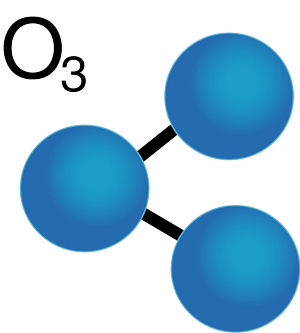 Ozone is a form of oxygen but unlike regular oxygen, it is composed of three oxygen atoms instead of two. The addition of the third oxygen atom makes ozone “supercharged” oxygen, and gives it all of its remarkable medical properties. Anything can be toxic to the human body if given in amounts that exceed the body’s capacity to utilize it. Ozone is found naturally in the body. White cells translate ozone as part of the immune response, allowing pure medical grade ozone to have a safety record that is unparalleled.
Ozone is a form of oxygen but unlike regular oxygen, it is composed of three oxygen atoms instead of two. The addition of the third oxygen atom makes ozone “supercharged” oxygen, and gives it all of its remarkable medical properties. Anything can be toxic to the human body if given in amounts that exceed the body’s capacity to utilize it. Ozone is found naturally in the body. White cells translate ozone as part of the immune response, allowing pure medical grade ozone to have a safety record that is unparalleled.
Ozone therapy is a unique form of therapy that both heals and detoxifies at the same time. It is used to treat a variety of chronic disease including cardiovascular disease, diabetes, Lyme disease, chronic hepatitis, herpes, chronic fatigue states, chemical sensitivity, macular degeneration, chronic bladder conditions, colitis, auto-immune diseases, Crohn’s disease, arthritis, heart disease, Alzheimer’s dementia, Lyme, among others. Ozone’s medical properties consist of the following:
- Ozone is a potent regulator of the immune system. If the immune system is overactive (as in auto-immune disease), ozone will calm it down. Conversely, if the immune system is under active as in chronic infections, ozone will stimulate it. Ozone’s ability to influence the immune system stems from its action on the membranes of white cells, causing them to produce immune related messenger molecules called cytokines.
- Ozone stimulates increased uptake of oxygen by stimulating diphosphoglycerate (DPG). DPG allows the release of oxygen from the hemoglobin molecule so that it can be used at the cellular level.
- Ozone improves circulation. This effect enables more of the oxygen carrying hemoglobin to reach the capillaries where the cells will receive more of the oxygen they require. This is a huge benefit to those suffering with chronic inflammation.
- Ozone increases antioxidant protection, even more than therapies containing vitamin C.
- Ozone is a powerful mitochondrial stimulant. The fundamental underlying cause behind all degenerative disease is decreased mitochondrial energy production. Ozone can often correct this problem.
Ozone therapy consists of the introduction of ozone into the body via the vagina, rectum, intramuscular (in a muscle), subcutaneously (under the skin), or intravenously (directly into veins). IV Ozone can also be introduced via autohemotherapy, in which blood is drawn from the patient, exposed to ozone and re-injected into the patient. This is the most common and effective method of Ozone administration. Generally 50-60 cc of blood is removed into a sterilized syringe and then added to a sterile bag of IV fluid with Heparin to prevent clotting. Immune complexes are added to the IV fluid/blood and then readministered to the patient via Intravenous access. The entire procedure takes about 30-40 minutes.
As mentioned above, ozone can be injected into a joint, muscle, or area of pain and is often referred to as Prolozone. Prolozone uses the power of ozone to heal damaged tissues, joints, ligaments, and tendons; allowing for regeneration. Prolozone can induce complete healing and a permanent end to pain. Prolozone works by infiltrating an area of injury or pain with oxygen in the form of ozone. The tissues get what they need to heal and the circulation to the area is re-established. Response to treatment varies from person to person however, most see therapeutic benefits after just one treatment.


